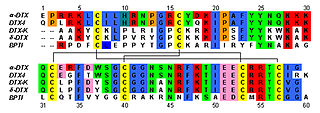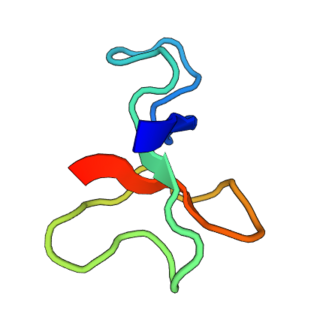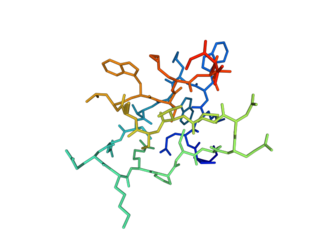Related Research Articles

Dendrotoxins are a class of presynaptic neurotoxins produced by mamba snakes (Dendroaspis) that block particular subtypes of voltage-gated potassium channels in neurons, thereby enhancing the release of acetylcholine at neuromuscular junctions. Because of their high potency and selectivity for potassium channels, dendrotoxins have proven to be extremely useful as pharmacological tools for studying the structure and function of these ion channel proteins.

Stichodactyla helianthus, commonly known as sun anemone, is a sea anemone of the family Stichodactylidae. Helianthus stems from the Greek words ἡλιος, and ἀνθος, meaning flower. S. helianthus is a large, green, sessile, carpet-like sea anemone, from the Caribbean. It lives in shallow areas with mild to strong currents.
AETX refers to a group of polypeptide neurotoxins isolated from the sea anemone Anemonia erythraea that target ion channels, altering their function. Four subtypes have been identified: AETX I, II, III and K, which vary in their structure and target.
Hainantoxins (HNTX) are neurotoxins from the venom of the Chinese bird spider Haplopelma hainanum. Hainantoxins specifically inhibit tetrodotoxin-sensitive Voltage-gated sodium channels, thereby causing blockage of neuromuscular transmission and paralysis. Currently, 13 different hainantoxins are known, but only HNTX-I, -II, -III, -IV and -V have been investigated in detail.
Huwentoxins (HWTX) are a group of neurotoxic peptides found in the venom of the Chinese bird spider Haplopelma schmidti. The species was formerly known as Haplopelma huwenum, Ornithoctonus huwena and Selenocosmia huwena. While structural similarity can be found among several of these toxins, HWTX as a group possess high functional diversity.
Halcurin is a polypeptide neurotoxin from the sea anemone Halcurias sp. Based on sequence homology to type 1 and type 2 sea anemone toxins it is thought to delay channel inactivation by binding to the extracellular site 3 on the voltage gated sodium channels in a membrane potential-dependent manner.
Calitoxin, also known as CLX, is a sea anemone neurotoxin produced by the sea anemone Calliactis parasitica. It targets crabs and octopuses, among other invertebrates. Two isoforms have been identified, both of which are formed from precursors stored in the stinging cells of the anemone. Once the toxin is activated and released, it causes paralysis by increasing neurotransmitter release at invertebrate neuromuscular junctions. Along with several other toxins derived from anemones, CLX is useful in ion channel research. Certain structural aspects of calitoxin are dissimilar from sea anemone toxins that also target the sodium ion channels. Other toxins resembling calitoxin function in completely different ways.
Cangitoxin, also known as CGTX or CGX, is a toxin purified from the venom of the sea anemone Bunodosoma cangicum, which most likely acts by prolonging the inactivation of voltage-gated sodium channels.
BgK is a neurotoxin found within secretions of the sea anemone Bunodosomagranulifera which blocks voltage-gated potassium channels, thus inhibiting neuronal repolarization.
CgNa is a peptide toxin isolated from the sea anemone Condylactis gigantea. It causes an increased action potential duration by slowing down the inactivation of tetrodotoxin-sensitive sodium channels.
Kaliseptine (AsKS) is a neurotoxin which can be found in the snakelocks anemone Anemonia viridis. It belongs to a class of sea anemone neurotoxins that inhibits voltage-gated potassium channels.
Blood-depressing substance-1 (BDS-1), also known as kappa-actitoxin-Avd4a, is a polypeptide found in the venom of the snakelocks anemone Anemonia sulcata. BDS-1 is a neurotoxin that modulates voltage-dependent potassium channels, in particular Kv3-family channels, as well as certain sodium channels. This polypeptide belongs to the sea anemone type 3 toxin peptide family.
Kalicludine (AsKC) is a blocker of the voltage-dependent potassium channel Kv1.2 found in the snakeslocks anemone Anemonia viridis, which it uses to paralyse prey.

BcIII is a polypeptide sea anemone neurotoxin isolated from Bunodosoma caissarum. It targets the site 3 of voltage-gated sodium channels, thus mainly prolonging the inactivation time course of the channel.
ATX-II, also known as neurotoxin 2, Av2, Anemonia viridis toxin 2 or δ-AITX-Avd1c, is a neurotoxin derived from the venom of the sea anemone Anemonia sulcata. ATX-II slows down the inactivation of different voltage-gated sodium channels, including Nav1.1 and Nav1.2, thus prolonging action potentials.

GiTx1 (β/κ-theraphotoxin-Gi1a) is a peptide toxin present in the venom of Grammostola iheringi. It reduces both inward and outward currents by blocking voltage-gated sodium and potassium channels, respectively.
AsKC11 is a toxin found in the venom of the sea anemone, Anemonia sulcata. This toxin is part of the Kunitz peptide family and has been shown to be an activator of G protein-coupled inwardly-rectifying potassium (GIRK) channels 1/2, involved in the regulation of cellular excitability.
Toxin BF9 is a Kunitz-type peptide, coming from snakes, with a dual functionality. The toxin is able to inhibit both serine proteases and potassium channels.
Kunitz-type serine protease inhibitor APEKTx1 is a peptide toxin derived from the sea anemone Anthopleura elegantissima. This toxin has a dual function, acting both as a serine protease inhibitor and as a selective and potent pore blocker of Kv1.1, a shaker related voltage-gated potassium channel.

RTX-III (neurotoxin-III,δ-SHTX-Hcr1a) is a neurotoxin peptide derived from the Sebae anemone Radianthus crispa. The toxin targets voltage-dependent sodium channels by preventing its complete inactivation, which can lead to a prolonged influx of sodium ions and depolarization of the cell's membrane.
References
- 1 2 3 4 5 6 7 8 9 10 11 12 13 14 15 16 17 18 19 20 21 Honma, T.; Kawahata, S.; Ishida, M.; Nagai, H.; Nagashima, Y.; Shiomi, K. (2008). "Novel peptide toxins from the sea anemone Stichodactyla haddoni". Peptides. 29 (4): 536–44. doi:10.1016/j.peptides.2007.12.010. PMID 18243416. S2CID 207356560.
- ↑ Castañeda, O.; Harvey, A. L. (2009). "Discovery and characterization of cnidarian peptide toxins that affect neuronal potassium ion channels". Toxicon. 54 (8): 1119–24. Bibcode:2009Txcn...54.1119C. doi:10.1016/j.toxicon.2009.02.032. PMID 19269305.
- 1 2 3 4 Honma, T.; Hasegawa, Y.; Ishida, M.; Nagai, H.; Nagashima, Y.; Shiomi, K. (2005). "Isolation and molecular cloning of novel peptide toxins from the sea anemone Antheopsis maculata". Toxicon. 45 (1): 33–41. Bibcode:2005Txcn...45...33H. doi:10.1016/j.toxicon.2004.09.013. PMID 15581681.
- ↑ Ishida, Masami; Minagawa, Sonomi; Miyauchi, Koji; Shimakura, Kuniyoshi; Nagashima, Yuji; Shiomi, Kazuo (1997). "Amino Acid Sequences of Kunitz-type Protease Inhibitors from the Sea Anemone Actinia equina". Fisheries Science. 63 (5): 794–798. Bibcode:1997FisSc..63..794I. doi: 10.2331/fishsci.63.794 .
- 1 2 3 Schweitz, H.; Bidard, J. N.; Frelin, C.; Pauron, D.; Vijverberg, H. P.; Mahasneh, D. M.; Lazdunski, M.; Vilbois, F.; Tsugita, A. (1985). "Purification, sequence, and pharmacological properties of sea anemone toxins from Radianthus paumotensis. A new class of sea anemone toxins acting on the sodium channel". Biochemistry. 24 (14): 3554–61. doi:10.1021/bi00335a025. PMID 2412579.
- ↑ Frelin, C.; Vigne, P.; Schweitz, H.; Lazdunski, M. (1984). "The interaction of sea anemone and scorpion neurotoxins with tetrodotoxin-resistant Na+ channels in rat myoblasts. A comparison with Na+ channels in other excitable and non-excitable cells". Molecular Pharmacology. 26 (1): 70–4. PMID 6146926.
- ↑ Nagata, K.; Hide, M.; Tanaka, T.; Ishii, K.; Izawa, M.; Sairenji, T.; Tomita, K.; Shimizu, E. (2006). "Anaphylactic shock caused by exposure to sea anemones". Allergology International. 55 (2): 181–4. doi: 10.2332/allergolint.55.181 . PMID 17075255. S2CID 28568524.